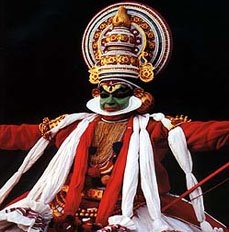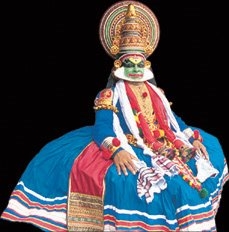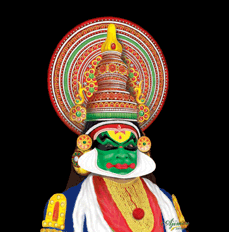Performances of Kathakali


Kathakali performances are not confined to a temple’s courtyard; they are held in the open under the sky. Before a performance begins, chendakkaaran the instrumental musician, beats the drum to announce the news that a dance -drama will be held shortly. This nervous and insistent tattoo’ is called Ke’likottu. The village folk-men, women and children begin to assemble and crouches on the land in a circle around chendakkaaran. The night’s ‘stadium’ has the covering of a clear, star-studded sky; cool breeze rustling through the jagged patterns of palm fronds, children wandering back and forth aimlessly or running to a hawker or pestering their mothers or aping a character of a previous play; people discussing a role-type, an actor, a character, a story or a matter of current or religious interest. And those among the audience who are tired from the day’s hard work on their fields go back and sleep until they are awakened by a relative or a friend or by the noise from the stage, to witness the favorite hero play or a climatic battle scene.
In its indigenous form, Kathakali has no stage in the modern sense. The centre of the stadium is the stage provided with a huge brightly polished brass lamp of coconut oil. The audience sits in darkness.
There are no back-curtains, no stills, no sceneries. But behind the lamp there is a simply designed ‘tirasila’, a rectangular silk curtain, held by two members of the troupe. Actors who have to appear first stand hidden behind it. During scenes the curtain is dropped to the ground and removed by the two men. The job over, these men go about on other errands of the stage, like pouring oil in the lamp-well ,adjusting the thick wicks which constantly threaten to gutter and burn out, arranging the banana tree trunk support against the wicks gliding down in the well, and assisting the actors on odd jobs. The stage is also provided with a small stool. This is used for many purposes. For instance, in the ‘curtain look’ the actor stands on it; on other occasions an actor may rest on it.
Musicians stand in a half circle behind the actors. They number four to twelve. Musicians do not wear any special costume. They are normally bare-chested. The actors are profusely dressed mostly in billowing skirts, crowned with massive head-dresses and provided with the accessories of the face and finger nails. The ‘actresses’ are adolescent boys, for they are nearest to feminity and have simple dress.
In the repertoric of its technique Kathakali has seven items to be presented in the following sequence:
1. To’dayam- the basic nritt;
2. Purappaadu- debut of the hero and the virtuous character;
3. Tirano’kku- ‘curtain look’ by evil characters and demons;
4. Kummi- permeable for the female character’s appearance
5. Kathakali- the main play
6. Kalaasham- a passage of vigorous dance which serves as a hyphen between two pieces of verse-play and
7. The concluding benediction dance
The dance drama begins with the call of the drum which has rent the air at night. The audience is alerted.
Tirasiila is drawn by two men. Music begins. Drummers display their cleverness. Religious songs are sung. They purify the atmosphere. And dancers are behind the curtain. The preliminary dance behind the curtain is commonly refused to as Purva-ranga by Bharata in the Naatya saastra, in the language of Kathakali it is called To’dayam. The basic technique of Kathakali lies in To’dayam.
Purappaadu or the debut, signifies the first appearance of a character on the stage. It is a piece of a preliminary dance. It serves to announce the virtuous qualities of the hero. If a demon is to appear violent drumming of high pitch drums is incessant. The curtain is drawn as high as the arms of the attendants can stretch. The whole atmosphere is surcharged with earth-shaking and hair raising activities. The sound of quick and heavy foot steps can be heard from behind the curtain. Its synchronisation with the sound effect of the drums heightens the climax. The entire climate forebodes that a terrific personality is about to appear. Suddenly a coloured canopy appears over the curtain and a rumbling growling noise is heard. Drums burst into shattering sounds. Here is a shrick, and there a groan. But before the eyes can catch the character, fingers are seen rising in the centre of the curtain. The left hand fingers are covered with long thimbles. The two hands are kept about three feet apart. They clutch the curtain. Fingers glide across its top.
There is deafening drumming; but no singing.
To the accompaniment of the drums, the anti-hero shakes the curtain violently, and breathless the audience catches an occasional glimpse of the top of a glittering head-dress, which seems to be gyrating madly in some internal whirlwind. He pulls the curtain towards him; then plugs forward and fans flames. With gusto, the fire illuminates the character’s face and enables the audience to spot him out by his weird makeup.
The feverish pitch of excitement over, the curtain is dropped and the whole figure of the character emerges after a great deal of suspense. The curtain is pulled off the stage from its right wing. Thus develop tirano’kku or ‘curtain look’.
For male anti-heroes Tirano’kku is prescribed and for female characters there is another standard dance called Kummi. In it gestures and movements are modified and smoothened to lend gentleness and elegance. so much necessary for feminine characters. Paces are slow; roles are passive and subsidiary.
Kalaasams are pure dance passages performed in pure taandava style. They punctuate two verses; two scenes. It is here that in Kathakali an important role of nritta is discovered.
From the sequence detailed Kathakali’s basic characteristic of a dance-cum-drama is unfolded. How the various limbs of sangiitha have been synthesized to bring about an underlying unity of all Indian dramatic arts in Kathakali is unique. It is the only form of the histrionic arts in India, which adumbrates in principle, the three essentials of the Sanskrit drama, naatya, nritya and nritt.

